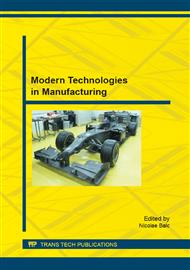p.131
p.137
p.143
p.149
p.155
p.161
p.169
p.175
p.181
Some Researches Regarding the Surface Quality when Drilling Carbon Fiber Reinforced Composites
Abstract:
In this paper, an attempt has been made to model the surface roughness through response surface method (RSM) and ANOVA when drilling CFRP composites. Drilling is the most common machining process applied to CFRP. However, the users of this kind of composites are facing difficulties to machining it, due to its properties. Because of the bad effects that lubricants have on the fiber-reinforced composites, the machining of these materials is performed without coolant. On the other hand dry machining offers the risk of a thermal damage induced by high process temperatures. The current experimental analysis is focused towards determining process temperatures with different tools and drilling parameters.
Info:
Periodical:
Pages:
155-160
Citation:
Online since:
November 2015
Authors:
Price:
Сopyright:
© 2015 Trans Tech Publications Ltd. All Rights Reserved
Share:
Citation:


